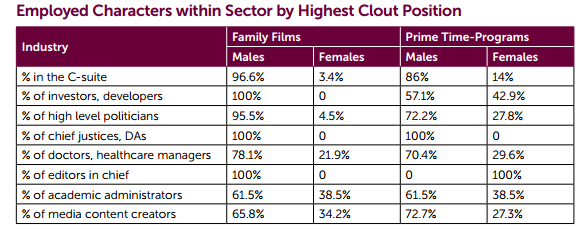by Ria Desai
The Geena Davis Institute on Gender and Media’s latest findings are out, and boy, are they looking bleak. There’s nothing like hard data to really hit home about how few women we see in media. The institute analyzed media by breaking the numbers down into three categories: films rated G, PG, and PG-13, prime-time programming, and children’s shows.
The overall finding is that women are still underrepresented in American media. When we are represented, we are still stereotyped and sexualized, more often depicted as unemployed in comparison to men, and rarely portrayed in STEM careers or in high ranking positions like CEO or President.
In films, prime-time programming, and children’s shows, fewer than 50% of speaking characters are women. Men outnumber women more than 2 to 1 in family films and children’s shows. The most dismal numbers represent the percentage of stories with gender-balanced casts: only 11% of family films, 22% of prime-time TV, and 19% of children’s shows feature balanced casts. A breakdown of characters by race indicates that characters are predominantly male, with the exception of Hispanic and Asian female characters in children’s shows. Women are also more likely to be found speaking in reality shows (48.1%) and news magazines (46.6%) rather than in comedies (31.5%) or children’s shows (30.5%).

Female characters in television are still subjected to gender roles and sexualization. In terms of domesticity, women are more likely than men to be depicted as parents or in stable relationships in children’s shows and family films. In terms of sexualization, women and girls are more likely to be wearing revealing outfits or anything considered sexy in all three categories of media. A female characters’ sexiness is often verbally commented upon, outwardly acknowledging her status as “eye candy.” The Institute broke down sexy female characters by age group, examining the extent to which the emphasis on being sexy is placed on the characters at each age. It’s outrageous proof that sexualization is unavoidable, as every age group is forced to conform to rigid standards of “attractiveness.”

When women are 47% of US employees, but only 20.3% of employees in family films, 34% in prime time, 25.3% in children’s shows, you know we have a problem. And of course, when there working women in media, stereotypes abound. Women scientists in the media are most often seen working in the life and physical sciences rather than in math or computer science–male computer scientists and engineers outnumber women 14.25 to 1 in family films and 5.1 to 1 in prime time TV. Working women in films often hit the glass ceiling–only two of the characters in the Institute’s sample were in high paying positions with major clout. In both family films and primetime programs, 100% of DAs and Chief Justices were men. In family films, 95% of politicans were men (in primetime programming, 72% were men). This kind of under-representation undermines the ambitions of girls by intimating what specific careers are not “for us.”

The latest findings once again hammer home how misrepresented and underrepresented women are in the media. Media is a powerful tool because it has the power to spread stereotypes and sexualization. Until mass media changes its tune and commits to achieving parity in speaking roles, depicting women not only as employed but as high achievers, and ending the objectification of its female characters, we will not stop voicing our protest. Although the media may see us this way, we are not silent, pretty decorations.
[…] Read the full article about these findings at the SPARK Movement website. […]
As an artist who is focused on shifting attitudes towards women’s bodies I am happy to see SPARK encourage women of all ages to be proud of who they are and speak out against projections of women with which they do not agree or identify with.
[…] http://www.sparksummit.com/2013/03/29/surprise-women-in-media-are-sexualized-and-underemployed/ […]
[…] characters exist in the media to satisfy a male character’s needs or purpose in some way. This article on SPARK points out a study conducted at the Geena Davis Institute on Gender and Media about […]